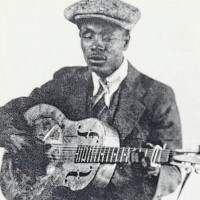Home » Jazz Musicians » Blind Boy Fuller
Blind Boy Fuller
During his short but prolific recording career, circa 1935- 1941, Piedmont bluesman Blind Boy Fuller was one of the most popular performers in the Southeast United States. His records sold in the thousands, (impressive numbers during the late-1930s) and his ability to perform in traditional blues, ragtime, hokum, and pop styles allowed him to reach the broadest audience possible. Possessing a bold, expressive voice and an impressive finger-picking style typical of Piedmont blues, Fuller and his steel National resonator guitar remained extremely popular both on record and in person until his death in 1941. Born Fulton Allen in rural North Carolina, Fuller learned to play the guitar at an early age, learning the traditional field hollers and country rag songs from older singers. He lost his sight sometime during his late-teens, and turned to playing street corners and in front of tobacco warehouses - where many African-Americans in the region worked - in cities like Durham and Raleigh. He met his wife Cora Mae Allen and settled down in Durham during the early-1930s. James Baxter Long (also known as J.B. Long), a local record retailer, heard Fuller perform and he arranged to have him record for the American Record Company (ARC). Long gave the guitarist his "Blind Boy Fuller" name, and became his manager, arranging to take the bluesman to New York City to record in 1935. With guitarist Gary Davis and washboard player Bull City Red (George Washington) in tow, Fuller recorded several sides for ARC, including the traditional "Rag, Mama, Rag." Between 1935 and 1940, Fuller recorded over 120 songs for a variety of labels, including ARC and Decca. Fuller's repertoire ranged from ragtime to the blues, including songs in the suggestive hokum vein such as "Truckin' My Blues Away" and "I Want Some Of Your Pie." Fuller typically recorded with other musicians, including guitarists Floyd Council and Brownie McGhee, and harpist Sonny Terry. Fuller proved to be a popular artist with Southern African- American record buyers, and his hits included both traditional and original songs like "Lost Lover Blues" and "Step It Up And Go." Many of Fuller's original songs have become standards of the Piedmont blues style, and lyrically his material drew upon his experience as a blind Black man in the South, accurately describing the poverty, sickness, and death that that plagued the African-American community. Fuller died young, in 1941 at the age of 33, of blood poisoning that resulted in kidney failure, popularly ascribed to his heavy drinking.
Source: Reverend Keith A. GordonTags
Photos
Music
Recordings: As Leader | As Sideperson
























